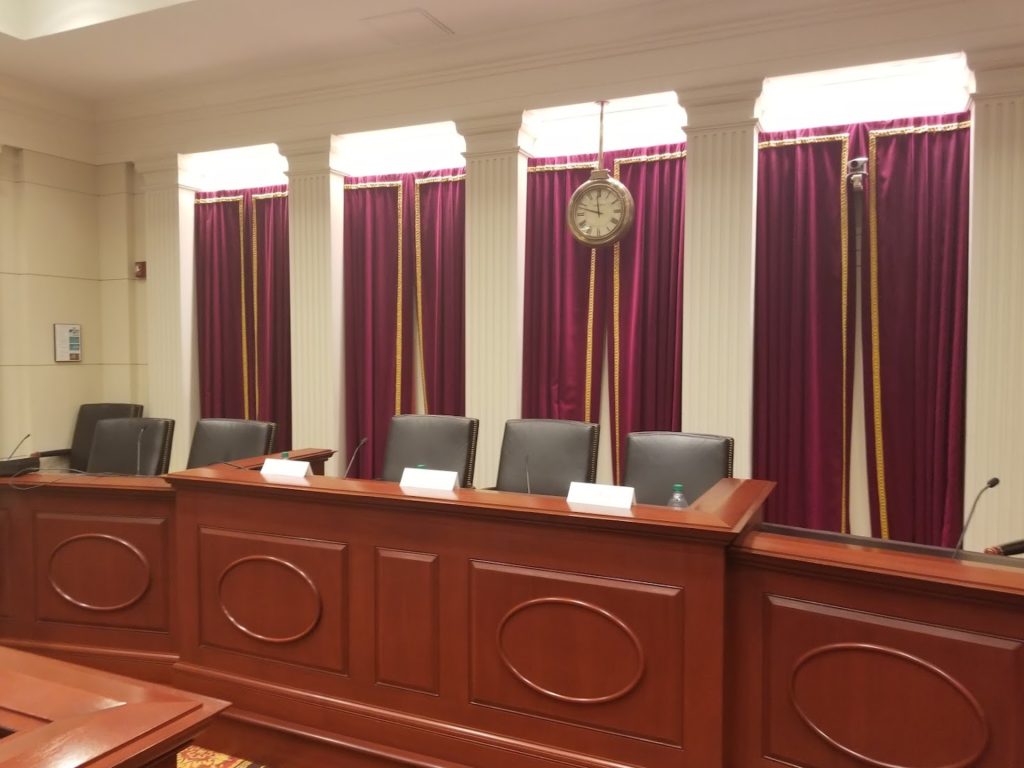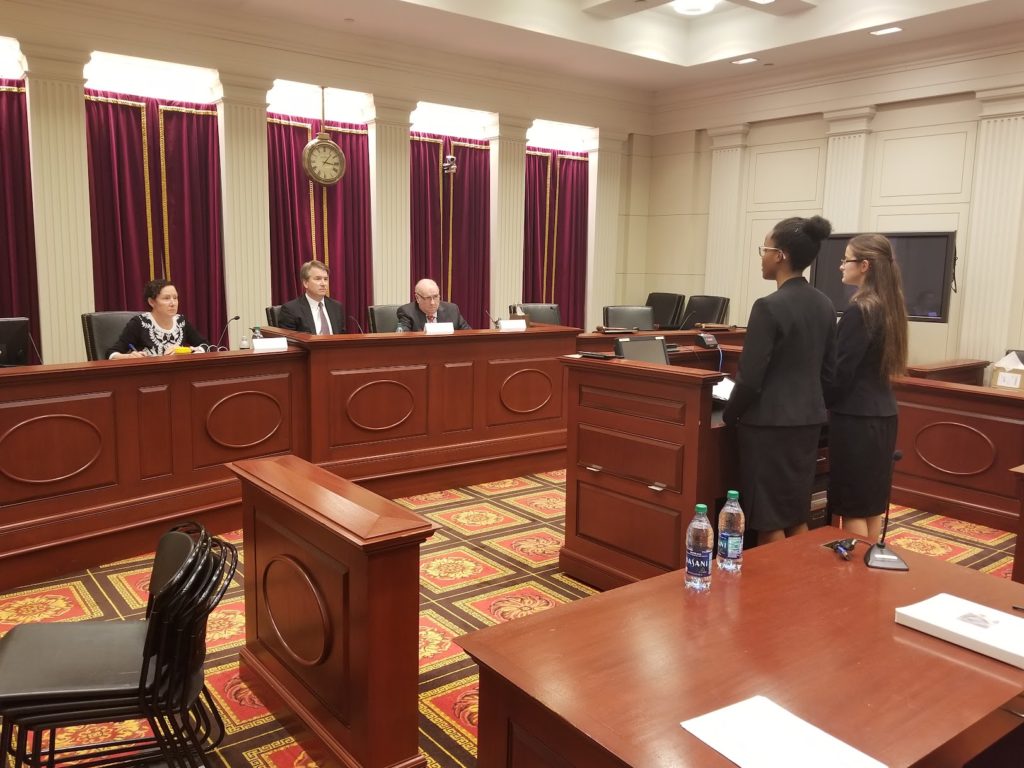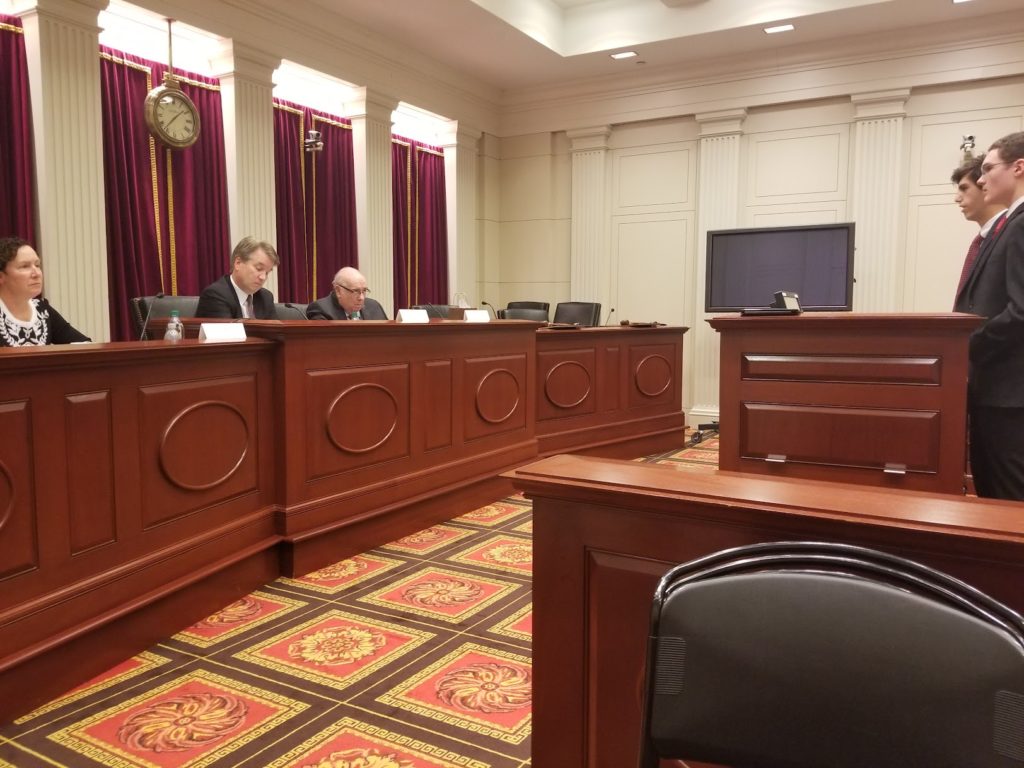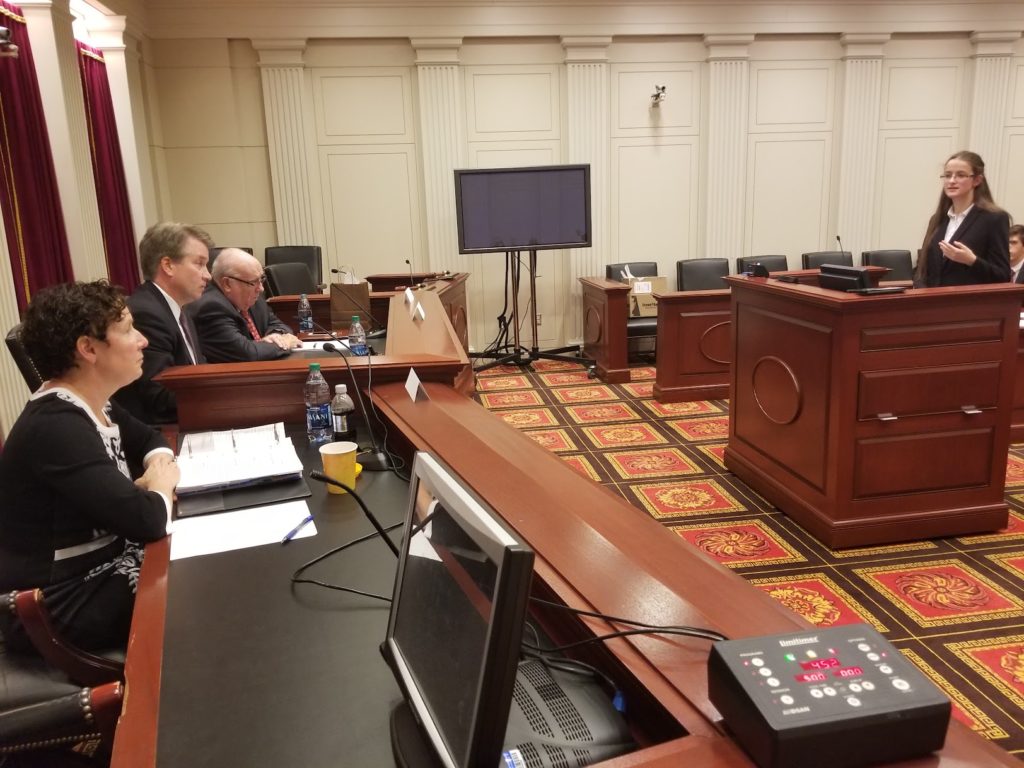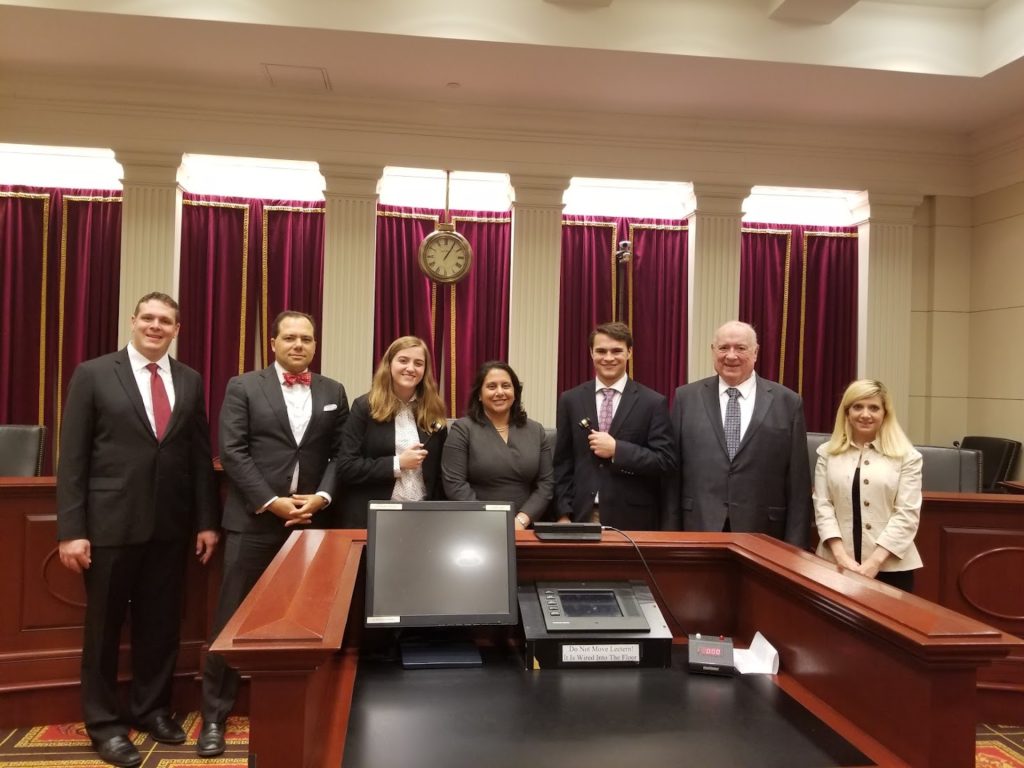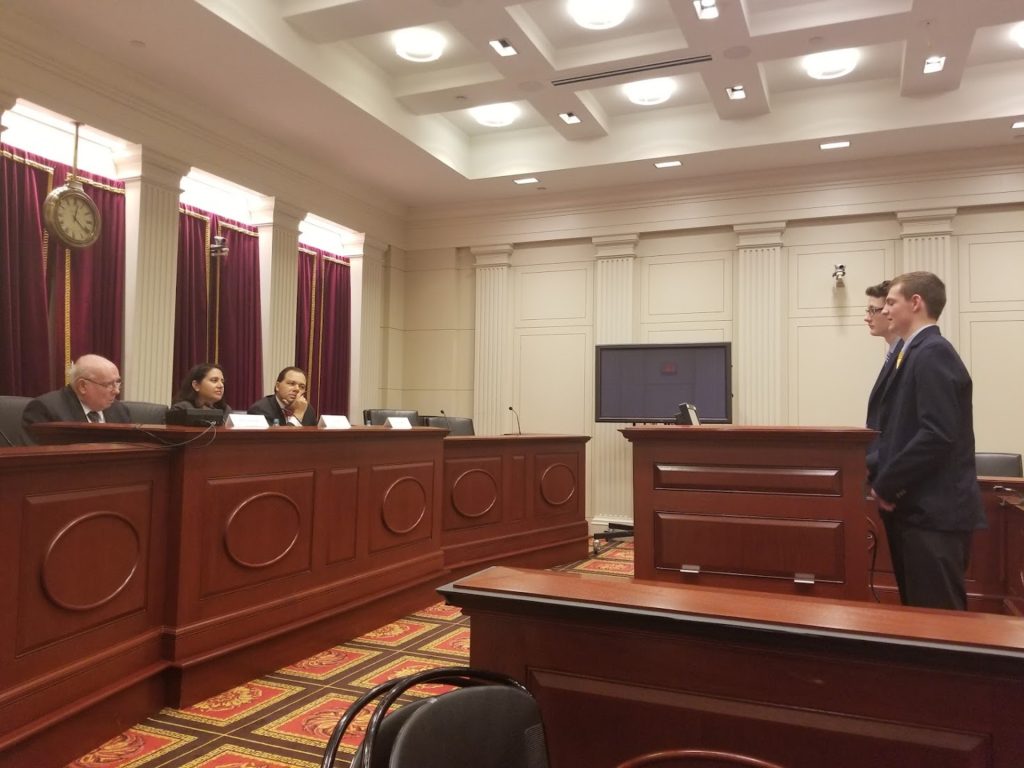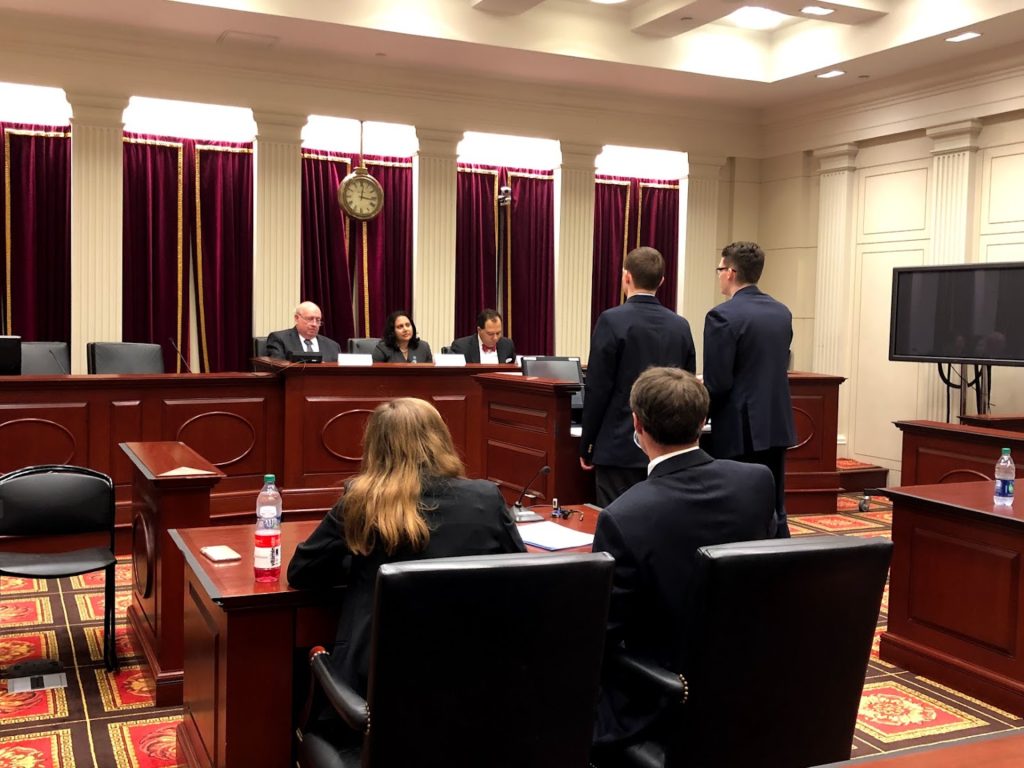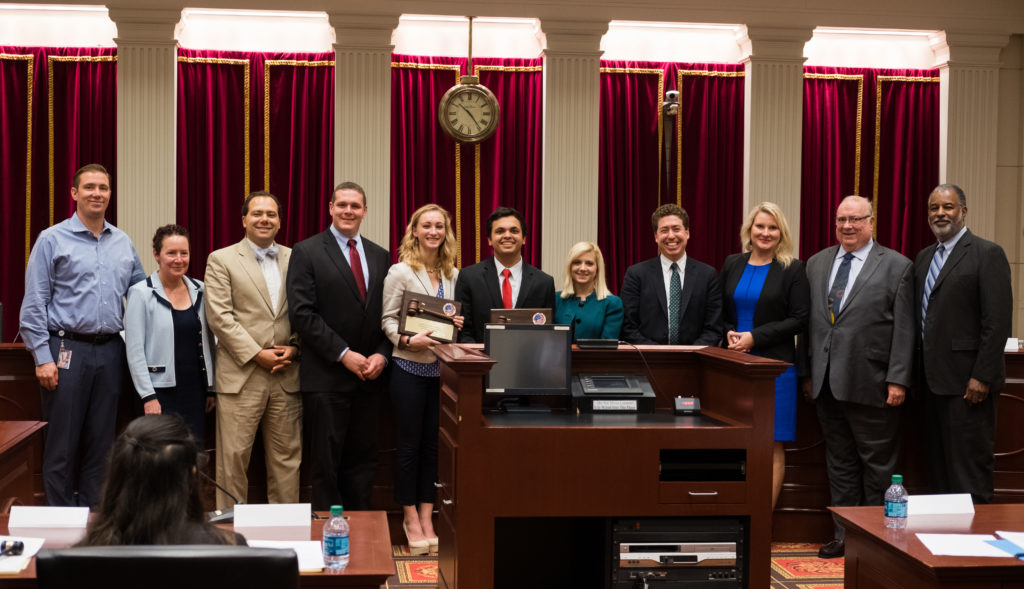New York State Rifle & Pistol Association, Inc., et al.
v.
Kevin P. Bruen, in His Official Capacity as Superintendent of New York State Police, et al.
Second Circuit Court of Appeals Summary Order (August 26, 2020)
Supreme Court Docket No. 20-843 (docketed on December 23, 2020)
Certiorari granted by the United States Supreme Court (April 26, 2021)
Oral Argument Scheduled for November 3, 2021
Case Information
Parties
- Petitioners:
- New York State Rifle & Pistol Association, Inc. (NRA state affiliate)
- Robert Nash
- Brandon Koch
- Respondents:
- Kevin P. Bruen, Superintendent of New York State Police
- Richard J. McNally, Jr., Justice of the New York Supreme Court, Third Judicial District, and Licensing Officer for Rensselaer County
Question Presented
Whether the Second Amendment allows the government to prohibit a law-abiding person from carrying handguns outside the home for self-defense.
Background
Facts
In September 2014, Robert Nash of New York applied for a concealed carry license. Nash was motivated to carry a gun because of recent robberies in his neighborhood. He had recently participated in a gun-training course. Nash had no criminal history. However, the license was denied. The government concluded that Nash did not demonstrate a special need, and thus lacked a proper cause.
In September 2014, Brendan Koch of New York also applied for a concealed carry license. Koch explained that self-defense and extensive firearm experience motivated his desire to carry a gun. Koch had no criminal history. Koch’s permit was also denied. The government found that Koch did not demonstrate a special need, and thus lacked a proper cause.
Nash and Koch (the Petitioners) sued two New York state officials: Superintendent of New York State Policy, Kevin P. Bruen (originally George Beach II), and Justice Richard McNally. New York State Rifle and Pistol Association (“NYSRPA”), a gun-rights advocacy group, joined this lawsuit on behalf of all other New Yorkers who cannot carry a gun because they lack the requisite proper cause.
Challenged Law
Under New York law, anyone who wishes to keep a gun inside their home or bear a gun outside of their home is generally prohibited from doing so without a license. N.Y. Penal Law §§ 265.01–04, 265.20(a)(3); N.Y Penal Law § 400.00. New York bans open carry in every form, but a resident may apply to a “licensing officer” for a concealed carry license.
Under this law, “[n]o license shall be issued or renewed” unless the officer finds the applicant exhibits good moral character, lacks a criminal or mental-illness record, and “no good cause exists for the denial of the license.” N.Y. Penal Law § 400.00(1)(a)–(n). Petitioners argue this discretionary standard operates as a de facto ban on the ability of law-abiding residents to carry a concealed handgun. See Kachalsky v. County of Westchester, 701 F.3d 91, 86 (2d Cir. 2012) (“New York bans carrying handguns openly, applicant[s] . . . who desire to carry a handgun outside the home and who do not fit within one of the employment categories must demonstrate proper cause”); see also N.Y. Penal Law § 400.00(2)(f).
To receive a license to carry “without regard to employment or place of possession,” an applicant must prove that “proper cause exists for the issuance thereof.” Kachalsky, 701 F.3d at 86. “Proper cause” is not defined in the statutory scheme, but “a substantial body of law instructing licensing officials on the application of [the proper cause] standard” exists. Id. The state imposes a very high standard to receive a license, as an applicant “must ‘demonstrate a special need for self protection distinguishable from that of the general community or of persons engaged in the same profession.” Id. (internal quotation omitted). For New York residents, a “generalized desire to carry a concealed weapon to protect one’s person and property does not constitute ‘proper cause.’” Id. It is not enough for a resident of good moral character who wishes to exercise a constitutional right. Likewise, living or working in a dangerous neighborhood is also insufficient. Id. at 86–87. The only way to establish the requisite proper cause to receive a license is to convince the licensing officer that the applicant is more deserving than other law-abiding people, and that the applicant seeks the license for a special self-defense reason. As a result, most New York residents cannot receive a license to carry.
Procedural History
Nash and Koch filed their lawsuit in the United States District Court for the Northern District of New York. The district court dismissed the case. It agreed with McNally that “Nash and Koch do not satisfy the ‘proper cause’ requirement because they do not ‘face any special or unique danger to [their] life.’” App. 6. The district court found that Kachalsky foreclosed the claims. App.2, 11–13. Nash and Koch appealed the decision to the Second Circuit, which summarily affirmed the dismissal.
Nash and Koch next appealed to the Supreme Court. The Court granted certiorari on August 26, 2021 on a single question presented: whether the denial of an application to carry a gun outside the home for self-defense purposes violated the Second Amendment.
Law
U.S. Constitution, Amendment II: “A well regulated Militia, being necessary to the security of a free State, the right of the people to keep and bear Arms, shall not be infringed.”
Sources and Materials
Supreme Court Filings
Briefs from the Petitioners and Respondents:
- Petition for Writ of Certiorari
- Opposition to Petition for Writ of Certiorari
- Reply ISO of Petition for Writ of Certiorari
- Petitioners’ Merits Brief
- Respondents’ Merits Brief
- Petitioners’ Merits Reply Brief
Amicus Briefs in Support of Petitioners:
- Professors of Second Amendment Law
- Mountain States Legal Foundation's Center to Keep and Bear Arms
- Citizens Committee for the Right to Keep and Bear Arms
- State of Arizona and other states
- Second Amendment Foundation
- The Cato Institute
- The Firearms Policy Coalition
- NRA Civil Rights Defense Fund
Amicus Briefs in Support of Respondents:
- The United States
- Everytown for Gun Safety
- Giffords Law Center to Prevent Gun Violence
- State of California and other states
- American Civil Liberties Union
- American Bar Association
- Professors of History and Law
- Brady
- National League of Cities
Supreme Court Cases
United States v. Miller, et al., 307 U.S. 174 (1939)
Holding: Under the National Firearms Act of 1934, regulating a sawed-off shotgun that travels across state lines is an appropriate exercise of Congress’s interstate-commerce power.
Quotations:
- “Second Amendment guarantees no right to keep and bear a firearm that does not have ‘some reasonable relationship to the preservation of efficiency of a well regulated militia.’” (quoted in Lewis v. United States, 45 U.S. 55, 65 n.8 (1980))
- “With obvious purpose to assure the continuation and render possible the effectiveness of such forces the declaration and guarantee of the Second Amendment were made. It must be interpreted with that end in view.”
- “In the absence of any evidence tending to show that possession or use of a 'shotgun having a barrel of less than eighteen inches in length' at this time has some reasonable relationship to the preservation or efficiency of a well regulated militia, we cannot say that the Second Amendment guarantees the right to keep and bear such an instrument.”
District of Columbia v. Heller, 554 U.S. 570 (2008)
Holding: The Second Amendment protects an individual right to keep and bear arms.
Quotations:
- “Putting all of these textual elements together we find that they guarantee the individual right to possess and carry weapons in case of confrontation. This meaning is strongly confirmed by the historical background of the Second Amendment. We look to this because it has always been widely understood that the Second Amendment, like the First and Fourth Amendments, codified a pre-existing right.”
- This case “. . . may well be just the first of an unknown number of dominoes to be knocked off the table,” should “the reality that the need to defend oneself may suddenly arise in a host of locations outside the home.” (Stevens, J., dissenting)
McDonald v. City of Chicago, 561 U.S. 742 (2010)
Holding: The Second Amendment also applies to state governments through the Fourteenth Amendment’s incorporation doctrine.
Quotations:
- The right “is fully applicable to the States”
- The Second Amendment is not a “second-class right”
- The Court would not “single[]” the Second Amendment “out for special—and specially unfavorable—treatment”
- In the early 18th Century, “States began to regulate the possession of concealed weapons, which were both popular and dangerous.” (Breyer, J., dissenting).
Caetano v. Massachusetts, 136 S.Ct. 1027 (2016) (per curiam)
Holding: Reinforcing Heller, the Court found that banning personal possession of a “stun gun” violated the Second Amendment notwithstanding the fact that such weapons were not “readily adaptable to use in the military.” The Court remanded the case without providing additional instructions to the lower court or any insight as to its Second Amendment stance.
Quotations:
- “‘[T]he Second Amendment extends, prima facie, to all instruments that constitute bearable arms, even those that were not in existence at the time of the founding.’ It is hard to imagine language speaking more directly to the point.” (quoting District of Columbia v. Heller, 554 U.S. 570, 582 (2008)) (emphasis in original)
- The “Massachusetts Supreme Judicial Court was wrong in the three reasons it offered for why the state could ban personal possession or use of a ‘stun gun’ without violating the Second Amendment.”
Lower Court Cases
- United States v. Jimenez, 895 F.3d 228 (2d Cir. 2018)
- Wrenn v. District of Columbia, 864 F.3d 650 (D.C. Cir. 2017)
- "[T]he individual right to carry common firearms beyond the home for self-defense—even in densely populated areas, even for those lacking special self-defense needs—falls within the core of the Second Amendment protections."
- Peruta v. County of San Diego, 824 F.3d 919 (9th Cir. 2016)
- NYSRPA, Inc. v. Cuomo, 804 F.3d 242 (2d Cir. 2015)
- Friedman v. City of Highland Park, 784 F.3d 406 (7th Cir. 2015)
- Jackson v. City and County of San Francisco, 746 F.3d 953 (9th Cir. 2014)
- Peterson v. Martinez, 707 F.3d 1197 (10th Cir. 2013)
- Moore v. Madigan, 702 F.3d 933 (7th Cir. 2012)
- "Heller repeatedly invokes a broader Second Amendment right than the right to have a gun in one’s home, as when it says that the amendment 'guarantee[s] the individual right to possess and carry weapons in case of confrontation.'" (quoting District of Columbia v. Heller, 554 U.S. 570, 582 (2008)) (alteration in original).
- Kachalsky v. Cty. of Westchester, 701 F.3d 81 (2d Cir. 2012)
- Hightower v. City of Boston, 693 F.3d 61 (1st Cir. 2012)
- United States v. Decastro, 682 F.3d 160 (2d Cir. 2012)
- Ezell v. City of Chicago, 651 F.3d 684 (7th Cir. 2011)
- Heller v. District of Columbia, 670 F.3d 1244 (D.C. Cir. 2011)
- United States v. Booker, 644 F.3d 12 (1st Cir. 2011)
- United States v. Chester, 628 F.3d, 673 (4th Cir. 2010)
- United States v. Reese, 627 F.3d 792 (10th Cir. 2010)
- United States v. Vongxay, 594 F.3d 1111 (9th Cir. 2010)
- United States v. Marzzarella, 614 F.3d 85 (3d Cir. 2010)
Historical Sources
English and Common Law Sources
- English Bill of Rights: “[T]he subjects which are Protestants may have arms for their defense suitable to their conditions and as allowed by law.” 1 W. & M., c. 2, 7, in 3 Eng. Stat. at Large 441 (1689).
- Cesare Beccaria, An Essay on Crimes and Punishments (1764) (translated by Voltaire)
- “Laws that forbid the carrying of arms ... disarm only those who are neither inclined nor determined to commit crimes. Such laws make things worse for the assaulted and better for the assailants; they serve rather to encourage than prevent homicides, for an unarmed man may be attacked with greater confidence than an armed one.”
- Laws that forbid the carrying of arms “. . . serve rather to encourage than to prevent homicides, for an unarmed man may be attacked with greater confidence than an armed man.”
- Blackstone’s Commentaries
- Blackstone described the right to keep and bear arms was “one of the fundamental rights of Englishmen”
- “THE fifth and last auxiliary right of the subject, that I shall at present mention, is that of having arms for their defence, suitable to their condition and degree, and fuch as are allowed by law. Which is also declared by the fame statute 1 W. & M. ft. 2. c. 2. and is indeed a public allowance, under due restrictions, of the natural right of resistance and self-preservation, when the sanctions of society and laws are found insufficient to restrain the violence of oppression.
- “The right of self defense is the first law of nature. . . . In most governments it has been the study of rulers to confine this right within the narrowest possible limits . . . and [when] the right of the people to keep and bear arms is, under any color or pretext whatsoever, prohibited, liberty, if not already annihilated, is on the brink of destruction.” (St. George Tucker, 1803)
Revolutionary-Era Sources
- John Adams, “Essay on Man’s Lust for Power” (August 29, 1763)
- “Power is a Thing of infinite Danger and Delicacy, and was never yet confided to any Man or any Body of Men without turning their Heads.—Was there ever, in any Nation or Country, since the fall, a standing Army that was not carefully watched and contrould by the State so as to keep them impotent, that did not, ravish, plunder, Massacre and ruin, and at last inextricably inslave the People.”
- The Rights of the Colonies – Stephen Hopkins (1764)
- Boston Resolution of 1768
- Massachusetts House of Representatives, Letter to Benjamin Franklin (November 6, 1770)
- “ . . . so wretched is the State of this Province, not only to be subjected to absolute Instructions given to the Governor to be the Rule of his Administration, whereby some of the most essential Clauses of our Charter vesting in him Powers to be exercised for the Good of the People are totally rescinded, which is in reality a State of Despotism; but also to a Standing Army, which being uncontrouled by any Authority in the Province, must soon tear up the very Foundation of civil Government.”
- Samuel Adams, The Rights of the Colonists (1772)
- Declaration of Independence (1776)
- “He has kept among us, in times of peace, Standing Armies without the Consent of our legislatures.”
- “He has affected to render the Military independent of and superior to the Civil power.”
- Articles of Confederation (1777)
- “. . . but every State shall always keep up a well-regulated and disciplined militia, sufficiently armed and accoutered, and shall provide and constantly have ready for use, in public stores, a due number of filed pieces and tents, and a proper quantity of arms, ammunition and camp equipage.”
- Massachusetts Declaration of Rights (1780)
- “The people have a right to keep and to bear arms for the common defence. And as in time of peace armies are dangerous to liberty, they ought not to be maintained without the consent of the legislature.”
Framing-Era Sources
- Thomas Jefferson, Letter to Secretary of State James Madison (December 20, 1787)
- “ . . . I will now add what I do not like. First the omission of a bill of rights providing clearly and without the aid of sophisms for freedom of religion, freedom of press, protection against standing armies, restriction against monopolies, the eternal and unremitting force of the habeas corpus laws, and trials by jury in all matters of fact triable by the laws of the land and not by the laws of Nations.”
- Federalist No. 29 – Hamilton (1788)
- “[T]he most natural defense of a free country.”
- "It requires no skill in the science of war to discern that uniformity in the organization and discipline in the militia would be attended with the most beneficial effects.”
- "It is, therefore, with the most evident propriety, that the plan of the convention proposes to empower the Union 'to provide for organizing, arming, and disciplining, the militia, and for governing such part of them as may be employed in the service of the United states…"
- “The project of disciplining all the militia of the United States is as futile as it would be injurious, if it were capable of being carried into execution. A tolerable expertness in military movements is a business that requires time and practice. It is not a day, or even a week, that will suffice for the attainment of it."
- "To oblige the great body of the yeomanry, and of the other classes of the citizens, to be under arms for the purposes of going through military exercises and evolutions, as often as might be necessary to acquire the degree of perfection which would entitle them to the character of a well-regulated militia, would be a real grievance to the people, and serious public inconvenience and loss. It would from an annual deduction from the productive labor of the country… to an amount which, calculating upon the present numbers of the people, would not fall far short of the whole expense of the civil establishments of all the States. To attempt a thing which would abridge the mass of labor and industry to so considerable an extent, would be unwise, and the experiment, if made, could not succeed, because it would not long be endured.”
- “Little more can reasonably be aimed at, with respect to the people at large, than to have them properly armed and equipped; and in order to see that this be not neglected, it will be necessary to assemble them once or twice in the course of a year."
- "This will not only lessen the call for military establishments, but if circumstances should at any time oblige the government to form an army of any magnitude that army can never be formidable to the liberties of the people while there is a large body of citizens, little, if at all, inferior to them in discipline and the use of arms, who stand ready to defend their own rights and those of their fellow citizens. This appears to me the only substitute that can be devised for a standing army, and the best possible security against it, if it should exist.”
- “In times of insurrection, or invasion, it would be natural and proper that the militia of a neighboring State should be marched into another, to resist a common enemy, or to guard the republic against the violence of faction or sedition.”
- Federalist No. 37 – Madison (1788)
- “All new laws . . . are considered as more or less obscure and equivocal, until their meaning be liquidated and ascertained by a series of particular discussions and adjudications.”
- Federalist No. 46 – Madison (1788)
- It may well be doubted, whether a militia thus circumstanced could ever be conquered by such a proportion of regular troops. Those who are best acquainted with the last successful resistance of this country against the British arms, will be most inclined to deny the possibility of it. Besides the advantage of being armed, which the Americans possess over the people of almost every other nation, the existence of subordinate governments, to which the people are attached, and by which the militia officers are appointed, forms a barrier against the enterprises of ambition, more insurmountable than any which a simple government of any form can admit of.”
- “The ultimate authority … resides in the people alone. … [T]he advantage of being armed, which the Americans possess over the people of almost every other nation … forms a barrier against the enterprises of ambition, more insurmountable than any…”
- “. . . a militia amounting to near half a million of citizens with arms in their hands, officered by men chosen from among themselves . . . and conducted by governments possessing their affections and confidence.”
- “The ultimate authority . . . resides in the people alone. . . . Besides the advantage of being armed, which the Americans possess over the people of almost every other nation, the existence of subordinate governments, to which the people are attached and by which the militia officers are appointed, forms a barrier against the enterprises of ambition, more insurmountable than any which a simple government of any form can admit of. Notwithstanding the military establishments in several kingdoms of Europe, which are carried as far as the public resources will bear, the governments are afraid to trust the people with arms. And it is not certain that with this aid alone they would not be able to shake off their yokes.”
- Federalist No. 78 – Hamilton (1788)
- “To avoid an arbitrary discretion in the courts, it is indispensable that they should be bound down by strict rules and precedents which serve to define and point out their duty in every particular case that comes before them.”
- Anti-Federalist No. 28 (1788)
- “[A] well regulated militia, composed of the Yeomanry of the country, have ever been considered as the bulwark of a free people.”
- Marquis de Lafayette, Declaration of the Rights of Man and of the Citizen (1789)
- Civil rights document from the French Revolution drafted in consultation with Thomas Jefferson.
- Article I, clause 8, § 15 “Power to Call Forth the Militia”
- “To provide for calling forth the Militia to execute the Laws of the Union, suppress Insurrections and repel Invasions;”
- Article I, clause 8, § 16 “Power to Organize Militias”
- “To provide for organizing, arming, and disciplining, the Militia, and for governing such Part of them as may be employed in the Service of the United States, reserving to the States respectively, the Appointment of the Officers, and the Authority of training the Militia according to the discipline prescribed by Congress.”
- New York’s Ratification of Constitution with Proposed Amendments (1788)
- “That the People have the right to keep and bear arms; that a well-regulated Militia, including the body of the People capable of bearing arms, is the proper, natural and safe defense of a Free State; that the Militia should not be subject to martial law, except in times of War, Rebellion, and Insurrection.”
- “That standing Armies in time of peace are dangerous to Liberty, and ought not to be kept up, except in Cases of necessity; and that at all times the Military should be under strict subordination to the civil Power.”
Post-Framing Sources
- Thomas Jefferson, Letter to Destutt de Tracy (January 26, 1811)
- “[T]he militia of the State, that is to say, of every man in it able to bear arms.”
- Gen. William H. Sumner, Letter to John Adams (May 3, 1823)
- “. . . essential to the preservation of our civil rights”
- “An enemy would be always unwilling to invade such a territory; but notwithstanding, if its population, like that of Europe, chiefly consisted of an unarmed peasantry, and its whole reliance was on its regular army, one pitched battle would decide its fate. But a country of well trained militia-men is not conquered when its army is beaten. . . . Here, every house is a castle, and every man is a soldier. Arms are in every hand, confidence in every mind, and courage in every heart. It depends upon its own will, and not upon the force of the enemy, whether such a country shall ever be conquered.”
- “It is true, that it is better that the arms should be kept by the men themselves, at their own dwellings, than in the public arsenals. They thus learn to take care of them, at least; and as opportunities for hunting and practical shooting offer, they improve as marksmen. But few boys would learn their catechisms, if the books which contained them, were to be found in the public libraries, only; and but few men would be familiar with the use of arms, which were not kept in their own possessions. . . . But where the country is settled, the general use of arms is given up; and as the forests are cleared, drilling becomes necessary as a substitute for that habitual exercise of shooting at game, which has obtained for Americans the reputation of being the best riflemen in the world. If this be not required in the populous parts of the country, the backwoodsmen alone will be able to defend themselves as none others will be accustomed to the use of the arms with which they are to be furnished.”
- John Adams, Response Letter to Gen. William H. Sumner (June 3, 1823)
- “Your manuscript dissertation concerning the militia . . . is so comfortable to all my opinions concerning it from my cradle, that it seemed to be living my life over again.”
- The American states have owed their existence to the militia for more than two hundred years. Neither schools, nor colleges, nor town meetings have been more essential to the formation and character of the nation than the militia.”
- “Impose its constitution by every prudent means, but never destroy its universality. A select militia will soon become a standing army. . . . Whenever the militia comes to an end, or is despised or neglected, I shall consider this union dissolved, and the liberties of North America lost forever.”
- Joseph Story. Commentaries on the Constitution of the United States. 3 vols. Boston, 1833, §§ 1890–91
- “The right of the citizens to keep and bear arms has justly been considered, as the palladium of the liberties of a republic; since it offers a strong moral check against the usurpation and arbitrary power of rulers . . . and will generally, even if these are successful in the first instance, enable the people to resist and triumph over them.”
- "The right of the citizens to keep and bear arms has justly been considered, as the palladium of the liberties of a republic; since it offers a strong moral check against the usurpation and arbitrary power of rulers. . . . And yet, though this truth would seem so clear, and the importance of a well regulated militia would seem so undeniable, it cannot be disguised, that among the American people there is a growing indifference to any system of militia discipline, and a strong disposition, from a sense of its burthens, to be rid of all regulations. How is it practicable to keep the people duly armed without some organization, it is difficult to see. There is certainly no small danger, that indifference may lead to disgust, and disgust to contempt; and thus gradually undermine all the protection intended by this clause of our national bill of rights.”
- Kansas Territory Wyandotte Constitution (1859)
- “The people have the right to bear arms for their defense and security, but standing armies, in time of peace, are dangerous to liberty, and shall not be tolerated, and the military shall be in strict subordination to the civil power.”
Secondary Sources
- Nelson Lund, The Past and Future of the Individual’s Right to Arms, 31 Ga. L. Rev. 1, 20-26 (1996)
- Eugene Volokh, The Commonplace Second Amendment, 73 N.Y.U. L. Rev. 793 (1998)
- Randy Barnett, Was the Right to Keep and Bear Arms Conditioned on Service in an Organized Militia?, 83 Tex. L. Rev. 237 (2004)
- Eugene Volokh, Necessary to the Security of a Free State, 83 Notre Dame L. Rev. 1 (2007)
- Carlton F.W. Lawson, Four Exceptions in Search of a Theory: District of Columbia v. Heller and Judicial Ipse Dixit, 60 Hastings L.J. 1371 (2009)
- Charles C. Branas et al., Investigating the Link Between Gun Possession and Gun Assault, 99 Am. J. Pub. Health 2034 (2009)
- Michael P. O’Shea, Modeling the Second Amendment Right to Carry Arms (I): Judicial Tradition and the Scope of “Bearing Arms” for Self-Defense, 61 Am. U. L. Rev. 585 (2012)
- Joseph Blocher, Firearm Localism, 123 Yale L.J.81 (2013).
- Lawrence Rosenthal, The Limits of Second Amendment Originalism and the Constitutional Case for Gun Control, 92 Wash. U. L. Rev. 1187 (2015)
- Eric M. Ruben & Saul Cornell, Firearm Regionalism & Public Carry: Placing S. Antebellum Case Law in Context, 125 Yale L.J. Forum 121 (2015)
- Patrick J. Charles, The Faces of the Second Amendment Outside the Home, Take Two, 64 Clev. St. L. Rev. 373 (2016)
- Stephen P. Halbrook, Taking Heller Seriously: Where has the Roberts Court Been, and Where is it Headed, on the Second Amendment?, 13 Charleston L. Rev. 175 (2019)
- Jonathan Taylor, The Surprisingly Strong Originalist Case for Public Carry Laws, 43 Harv. J.L. & Pub. Pol’y 347 (2020)
Tournament Instructions
Using historical materials related to the Second Amendment, and the precedents of the United States Supreme Court, teams of two high-school students will write an appellate brief, and present oral arguments, addressing this question:
- Does the Second Amendment allow the government to prohibit a law-abiding person from carrying handguns outside the home for self-defense?
Petitioners will argue that the Second Amendment prohibits states from denying a law-abiding person a license to carry a handgun outside the home.
Respondents will argue that the Second Amendment does not prohibit states from denying a law-abiding person a license to carry a handgun outside the home.
Phase 1 - Research and Write Your Brief
Coaches can register their teams at the Institute of Competition Sciences. After registering, teachers should contact the Harlan Institute and Ashbrook at info@HarlanInstitute.org. We will assign teams to argue on behalf of the Petitioners or the Respondents.
Teams will research and write their briefs. The brief must be a minimum of 2,000 words. Please download this template. The brief should have the following sections:
- Table of Cited Authorities: List all of the original sources, and other documents you cite in your brief.
- Summary of Argument: State your position succinctly in 250 words or less.
- Argument: Structure your argument based on at least five primary historical sources and at least three Supreme Court precedents. The more authorities you cite, the stronger your argument will be–and the more likely your team will advance.
- Conclusion: Summarize your argument, and argue how the Supreme Court should decide this issue.
Be sure to proofread your work. The work must be yours, and you may not seek help from anyone else–including attorneys or law students. Students who submit plagiarized briefs will be disqualified.
Please review the winning submissions from previous years:
- OT 2020 – Torres v. Madrid
- OT 2019 – Espinoza v. Montana Department of Revenue
- OT 2018 – Timbs v. Indiana
- OT 2017 – Carpenter v. United States
- OT 2016 – Trinity Lutheran Church v. Comer
- OT 2015 – Abigail Fisher v. University of Texas, Austin (II)
- OT 2014 – Zivotofsky v. Kerry
- OT 2013 – National Labor Relations Board v. Noel Canning
- OT 2012 – Abigail Fisher v. University of Texas, Austin (I)
Phase 2 - Virtual Mentoring
Teams that register before November 1, 2021 will be invited to participate in a virtual mentoring session. These sessions will be hosted during the week of November 15, 2021. The Harlan Institute will match each class with a mentor from our network. These sessions will be helpful to finalize your briefs and prepare your preliminary round arguments.
Phase 3 - Preliminary Round
For the preliminary round, each team must prepare a YouTube video. The argument must be at least 15 minutes in length. Coaches will ask their students the following ten questions:
- What does the Second Amendment protect?
- Why did the Framers include the Second Amendment in the Bill of Rights?
- What are the limits of the Second Amendment’s protection?
- What weapons does the term “arms” include?
- What is the difference, if any, between the verbs “keep” and “bear”?
- What is a militia and why did the Framers refer to it in the Second Amendment?
- How should courts determine if a gun control regulation is considered “long standing”?
- What is strict scrutiny? Intermediate scrutiny? Rational-basis review?
- Is there a difference between openly-carrying a firearm, and conceal-carrying a firearm?
- How should the Court consider the public safety implications of licenses to carry firearms?
Teams will upload a PDF of their brief, as well as a link to their YouTube video to the Institute of Competition Sciences. The deadline for the preliminary round will be December 15, 2021.
Phase 4 - Virtual Rounds
We will hold the Virtual Rounds over Zoom:
- 2/12/22 and 2/13/22: Semifinal Round
- 2/26/22 and 3/6/22: Round of 8
- 3/19/22 and 3/20/22: Round of 4
This video offers five tips to prepare for oral argument:
Phase 5 - Championship Round Rounds
The top teams will receive a free trip to Washington, D.C. to argue the championship round before federal judges on April 25-26, 2022.
Good luck! And register today.

